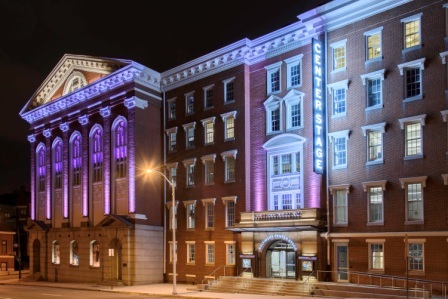Access for All
By Kelly Medinger
05-03-2018
Baltimore Center Stage uses arts and humanities grant to provide access for all
 When he’s not running the Front of House at Baltimore Center Stage, you might find Alec Lawson, Audience Services Manager, narrating one of the theater’s productions for a visually impaired audience member.
When he’s not running the Front of House at Baltimore Center Stage, you might find Alec Lawson, Audience Services Manager, narrating one of the theater’s productions for a visually impaired audience member.
The audience member wears an earbud, with Alec (or another trained member of his staff) providing a detailed, live audio description of the set, costumes, entrances and exits of each actor, and action on stage. “Doing a good audio description is tricky,” says Lawson. “You have to watch the show many, many times to learn how to break it down, and you have to share information strategically since you can’t talk while an actor is talking.”
About Baltimore Center Stage
Founded in 1963, Baltimore Center Stage is the City’s leading professional producing theatre, named the State Theatre of Maryland in 1978. It welcomes nearly 100,000 people each season from all 24 Maryland counties.
In 2017, the theatre completed a $33 million renovation, which included upgrades to the technology and services available to patrons with special access needs. The Knott Foundation supported Baltimore Center Stage with this work, awarding a grant for new assistive listening devices, improved captioning services, American Sign Language interpreted performances, increased audio description offerings, and more availability of Braille and large print programs.
An Enhanced Theatre Experience
Audiences are putting the new services and equipment to good use.
Approximately 750 people each season benefit from assistive listening devices and captioning services, and another 15 members subscribe to the American Sign Language interpreted performance of the mainstage productions. Braille and large print programs continue to be printed at 20 per show.
An average of 100 people also attend “touch tours” of the theatre each season, where they learn about a particular performance by touching props, costumes, and stage items. While staff originally designed the tours for the visually impaired, a large number of attendees have been children. “By opening the touch tours to everyone and attracting lots of kids, it has created a really nice sense of community where we can all interact together to experience theatre,” comments Lawson.
A Commitment to Diversity and Access
“Diversity and access are key priorities for Baltimore Center Stage,” notes Brandon Hansen, Institutional Giving Coordinator. He points to the evidence: One quarter of their audience identifies as a race other than white, and over a third of households have an annual income below $75,000. The newly renovated Head Theater is equipped with removable seats accessed immediately from the entrance ramp, with wheelchair accessible seats built into the theater’s design. Anyone can email access@centerstage.org with a question and one of eight staff members trained in accessibility issues will respond.
Baltimore Center Stage’s accessibility program has achieved national recognition, so much so that Lawson and a colleague have been invited to present at the Leadership Exchange for Arts and Disabilities. Their presentation will address how to create inclusive programs that reflect diverse communities, how diversifying opens perspectives and opportunities, and the role volunteers play in a successful accessibility program.
“Access for all applies to everyone,” emphasizes Lawson. “We often talk about access in the context of race or socioeconomic status, but access needs exist across a wide spectrum.” That could include people who have low vision, are hard of hearing, or have a family member with autism. “These groups with special access needs have often been taught to hide,” Lawson continues. “Here at Center Stage, we want to make theater a welcome place for everyone, to come as you are.”
